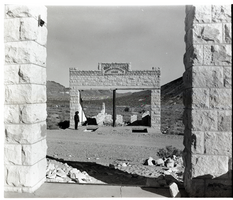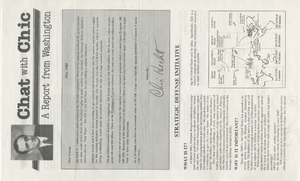Search the Special Collections and Archives Portal
Search Results
University of Nevada, Las Vegas School of Medicine Press Clippings and Publicity Collection
Identifier
Abstract
The University of Nevada, Las Vegas School of Medicine Press Clippings and Publicity Collection is comprised primarily of newspaper clippings and magazine articles from 2013 to 2015 covering the development of a medical school at UNLV. The collection materials include op-eds on UNLV's School of Medicine and articles discussing funding, development, and administration for the school. This collection also includes a copy of the
Archival Collection
Marisa Rodriguez oral history interview
Identifier
Abstract
Oral history interview with Marisa Rodriguez conducted by Maribel Estrada Calderón, Monserrath Hernández and Claytee D. White for the Latinx Voices of Southern Nevada Oral History Project.
Marisa Rodriguez discusses her childhood and living in North Las Vegas as a teenager; she was born in Chicago, Illinois, moved to Mexico with her family at a young age, and returned to the United States at age 12. She recounts what it was like acclimating to American life, learning English, and studying abroad in Spain before becoming a law student. Marisa attended the William S. Boyd School of Law and is currently a civil litigator in Las Vegas.
Subjects discussed include: La Voz Hispanic/Latino Law Students Association at the William S. Boyd School of Law; Huellas mentorship program.
Archival Collection
Paul E. Meacham Faculty Papers
Identifier
Abstract
The Paul E. Meacham Faculty Papers (approximately 1977-1998) are comprised of articles and reports relating to the development of community colleges as well as organization and administration in higher education throughout the United States. The collection also includes course readers for EDA 731 Organization and Administration in Higher Education taught at the University of Nevada, Las Vegas.
Archival Collection
Union Plaza Photograph Collection
Identifier
Abstract
The Union Plaza Photograph Collection, approximately 1970 to 1971, consists of photographic prints and negatives taken during the construction of the Union Plaza Hotel and Casino in downtown Las Vegas, Nevada. Images portray the construction process, the surrounding area and businesses, and the completed project.
Archival Collection
Breck Wall Photograph Collection
Identifier
Abstract
The Breck Wall Photograph Collection, approximately 1960 to 1980, consists of black-and-white photographic prints depicting comedian and entertainer, Breck Wall, and other cast members of the comedy revue, “Bottom’s Up!” in Las Vegas, Nevada. Images include scenes from sketches performed on the show, group shots of the cast members off-set, and portraits of Wall.
Archival Collection
Larry A. Strate Faculty Papers
Identifier
Abstract
The Larry A. Strate Faculty Papers (approximately 1985-2023) are comprised primarily of scholarly articles and papers from the Pacific Southwest Academy of Legal Studies in Business annual conferences written by Strate during his time as a business law professor at the University of Nevada, Las Vegas (UNLV). Materials also include personal memoir written by Strate about his life.
Archival Collection
Nevada State Senator Bob Coffin Records of the Kathy Augustine Impeachment Trial
Identifier
Abstract
Nevada State Senator Bob Coffin Records of the Kathy Augustine Impeachment Trial (2004) contains exhibits, testimonies, witness lists, questions posed, computer forensic evidence, correspondence, newspaper clippings, magazine articles, and printed legislative materials. Also included are 21 DVD recordings of the trial.
Archival Collection
Kathy Augustine Papers
Identifier
Abstract
The Kathy Augustine Papers date from 1977 to 1997 and are comprised of the documents of Augustine's political career as an Assemblywoman and State Senator in Nevada. The collection includes political correspondence relating to State Senate Bills (SB) and Assembly Bills (AB), material from Augustine's Assembly campaign, and newsletters from Desert Express, Sage, and Sagehen. The collection also includes other correspondence related to Augustine's time in office, and social events.
Archival Collection

Film transparency of the ruins of the H. D. and L. D. Porter Brothers Store, Rhyolite, Nevada, November 25, 1948
Date
Archival Collection
Description
Image

